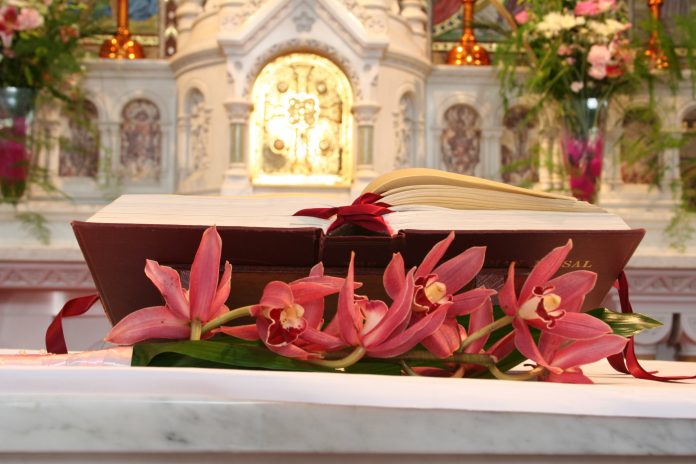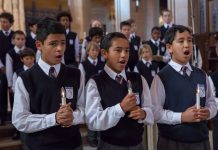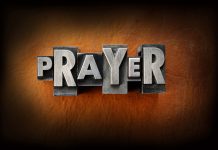
by Kate Ristow
For an idea to spark family interest in participating in the Holy Thursday Liturgy, see the end of this article.
Grandma Gallagher called Holy Thursday “Maundy Thursday.” Because Grandma emigrated from Ireland, I assumed that Maundy was the Gaelic word for “holy.” Assuming is never a good thing!
It turns out that Maundy is a derivative of the Latin word mandatum, which means “commandment.” It is a reference to the new commandment Jesus gave his disciples at the Last Supper: “Love one another” (John 13:34). This new commandment tells us that we must love each other as Christ loves us.
The Big Picture: The Triduum
Our students miss so much of the richness and meaning of Christ’s passion, death, and Resurrection if we neglect to teach them about Holy Thursday and the other celebrations of the Triduum. Print the word Triduum on the board and explain that it means “three days.” Point out that the Triduum is the heart and soul of the liturgical year and our faith. The Triduum begins at sundown on Holy Thursday and ends at sundown on Easter Sunday.
Work with students to create a chart on the board to help them better understand our celebration of the Triduum. Begin by asking them to name what we celebrate on Holy Thursday. Offer clues until they recognize that we recall the Last Supper on the first night of the Triduum.
Continue doing this until students acknowledge that on Good Friday we remember Jesus’ crucifixion and death and that on Holy Saturday evening we celebrate Jesus’ Resurrection. Help older students learn the formal names of the celebrations of the Triduum: Evening Mass of the Lord’s Supper; Good Friday of the Lord’s Passion; and the Easter Vigil.
Continuing to work with the chart, have students share their understanding of what takes place during each of these celebrations.
This can be a discouraging exercise, especially if you are working with older students. Many kids have never participated in any Triduum liturgies. Take care not to give the impression that you are checking up on them or blaming them for not celebrating the Triduum with the parish community. Frankly, if their parents were participating in these important days, the kids would be, too.
Light a Fire
Knowing the liturgies with which students are already familiar will help you see what they need to learn. Poll the class to determine which Triduum liturgies they have attended. Instead of being disheartened by what you learn, think of this as an opportunity to increase the students’ desire to participate more fully in the Triduum. Light a fire in them that they can carry home and share with their families!
Review the meaning of the word Easter. Eastre (Anglo Saxon) was a spring pagan festival celebrating the rising of the sun, new life, and new beginnings. At Easter, Christians celebrate the rising of the Son of God, Jesus Christ, and the everlasting new life made possible by his Resurrection.
Another name for Easter is Pascha (Greek) or Pesach (Hebrew)—the Passover of the Lord from death to new life.
* Tell students that Christians treasure the diary of a fourth-century Spanish pilgrim named Egeria who describes traveling to Jerusalem to celebrate Holy Week. When she returned home, she shared her observations with her church community.
Challenge older students to keep a Holy Week diary. Suggest they include observations about the parts of these days and liturgies that are the most meaningful to them and the reasons for their choices.
* Cut a piece of butcher paper to cover the entire outside of your classroom door. Invite students to work in teams to illustrate on the paper the first day of Holy Week—Palm Sunday of the Lord’s Passion—and the events of the Triduum.
The Origins of Holy Thursday Celebrations
The early Church celebrated Jesus’ passion, death, and Resurrection in one very long liturgy. There were two distinct parts of the liturgy. Beginning at sundown on Holy Saturday, the assembly gathered to remember Christ’s death on the cross; after midnight, the emphasis shifted to a celebration of Jesus’ Resurrection. In this part of the liturgy, new members were baptized and welcomed into the Church, and the assembly shared in the Eucharist.
Over time, a desire for a more historical focus resulted in the celebration of Jesus’ saving actions over three days. By the fourth century, a liturgy recalling the Last Supper was celebrated on Holy Thursday. Various elements were added over the years until it eventually became the meaningful liturgy we celebrate today.
Working with the Scriptures
Following the Introductory Rites, the Liturgy of the Word takes place. These are the Scriptures always used on Holy Thursday: First Reading, Exodus 12:1-8, 11-14; Second Reading, 1 Corinthians 11:23-26; Gospel, John 13:1-15.
* Arrange students into small groups and have groups read the Scriptures listed above. Older kids can study all three readings; younger students can focus solely on the Gospel. Ask groups to summarize the meaning of each reading and why each one is important for Catholics today. Read the Gospel aloud to first- and second-graders. Invite students to name specific ways they can show their love for others as Jesus commands.
* The First Reading relates the Lord’s call to the Jews to celebrate a memorial feast remembering the gift of freedom they received in the Exodus. Read aloud a condensed account of the Israelites’ journey from slavery to freedom from a Bible storybook. Talk with the class about the modern things that enslave us and the importance of freeing ourselves from anything that keeps us from putting God first in our lives.
* Invite a member of the Jewish faith to visit your class to explain to students how his or her family celebrates the Seder meal each year.
The Washing of the Feet
After the homily, the reenactment of Jesus’ call to service is demonstrated by the washing of the feet of 12 parishioners. Point out that these individuals represent each one of us and that Jesus came to serve all people. As you discuss this ritual with students, emphasize that in the last line of the Gospel, Jesus tells us that, “I have given you a model to follow, so that as I have done for you, you should also do” (John 13:15).
* Arrange students in pairs and instruct them to trace one another’s foot onto construction paper and cut it out. Have each student write on the footprint a sentence stating one way he or she will imitate Jesus by serving others in the coming week. Save the footprints. When class members fulfill their commitments, allow them to post their footprints on a bulletin board or poster.
* Invite students to imagine themselves as Peter. Ask them to write a short letter to a friend describing how they felt about Jesus washing their feet and how Jesus’ words helped them better understand how we share in Christ’s mission.
* Explain that during the Presentation of Gifts, members of the assembly process to the altar with gifts and money for the poor, in addition to the water, wine, and unconsecrated breads. This is a sign of the community’s response to Jesus’ call to serve others. In many parishes, food baskets for the needy are offered. Arrange for your class to contribute to this effort by working together to prepare one or more food baskets.
Do This in Memory of Me
Emphasize that Jesus instituted the Eucharist at the Last Supper. This is an important focus of the Evening Mass of the Lord’s Supper. Paul’s words in the Second Reading emphasize that in the Eucharist we remember and make present Jesus’ death and Resurrection.
* Have students compare the different Gospel accounts of the Last Supper and the institution of the Eucharist (Matthew 26:26-29; Mark 14:22-25; Luke 22:14-20). Ask students to note similarities and differences in the three versions and how they compare to our celebration of the Eucharist on Sunday.
* This is a good time to review and practice the proper way to receive the Eucharist. Show students how to make a reverent bow of the head before approaching the priest or extraordinary minister of the Eucharist. Practice this respectful gesture with the class. Remind students that when receiving Eucharist in the hand they should hold their hands high enough so that it is obvious to the minister that they want to receive the host in this manner. Remind students to reverently place the host in their mouth and then to make the Sign of the Cross.
The Stripping of the Altar and Sanctuary
Tell students that at Mass on Holy Thursday, the priest consecrates the hosts that will be used in the service on the following day because there is no Mass on Good Friday. After Communion, the hosts consecrated for Good Friday are incensed and brought to the tabernacle or Blessed Sacrament chapel in a solemn procession. This is followed by a time of silent adoration.
The altar and sanctuary are stripped in silence. This helps us focus on only what is truly important: Jesus. Stripping the sanctuary reminds us that nothing should distract us from concentrating on the mystery of Christ’s passion, death, and saving love.
There is no formal dismissal from the Evening Mass of the Lord’s Supper—no blessing, no songs. We may stay in silent adoration before the tabernacle or the empty sanctuary. We leave in silence, alone with our thoughts and prayers.
* Teach students the English and/or Latin lyrics to the hymn “Tantum Ergo,” which is taken from the last two verses of “Pange Lingua,” written by St. Thomas Aquinas. This hymn is sung when the Blessed Sacrament is placed in the tabernacle or place of adoration.
* Explain the tradition of the Forty Hours devotion. Point out that the forty hours represents the time Jesus remained in his tomb before rising from the dead. Share with the students how and when this devotion is celebrated in your parish. Arrange to have your students visit the Blessed Sacrament chapel or the church for a time of silent adoration in preparation for Holy Week.
The Evening Mass of the Lord’s Supper calls us to be servants to one another, to be grateful for being nourished by the Body and Blood of Christ, and to be committed to Christ’s command to love one another. It is the perfect way to begin our celebration of the Triduum.
The Chrism Mass
The Chrism Mass has its origins in the fourth century. There was a time when it was celebrated exclusively on Holy Thursday morning.
The Chrism Mass has a three-fold purpose. First, the three oils used in sacramental celebrations are blessed and distributed: chrism, used to anoint those who receive the Sacraments of Baptism, Confirmation, and Holy Orders; the oil of the sick, used to anoint those who are in need of healing; and the oil of catechumens, used to anoint those preparing for Baptism. During the Chrism Mass, priests renew the promises they made at ordination and parishioners have the opportunity to pray for and support their priests.
Because of the busyness of the day and the burden of traveling great distances to the diocesan cathedral and back to the parish, the Chrism Mass is often celebrated earlier in the week. The blessed oils may be formally received by the parish community during the Evening Mass of the Lord’s Supper.
* Brainstorm a suitable way for you and your students to express gratitude to your parish priest or priests for their ministry.
* Visit the church and show the students the place where the sacred oils are reserved. Briefly explain the purpose of each of the oils.
Kate Ristow, Contributing Editor to CATECHIST, is National Catechetical Consultant for RCL Benziger. She has been involved in children’s religious education for over 25 years as a Catholic-school teacher and parish catechist.
To spark family interest in participating in the Holy Thursday Liturgy:
Make Family Invitations
After teaching students about the elements of the Evening Mass of the Lord’s Supper, have students use a blank triptych template to create an invitation. Print it out (CLICK HERE) and duplicate it, one for each student. After decorating it with symbols representing what they have learned about the Holy Thursday liturgy, have them add information about the day, date, and time of the celebration in your parish. Show the kids how to fold in the right and left sides of the triptych so that it can be placed in an envelope, presented to parents, and opened at home.
As an alternative to the triptych invitations, talk with students about the different types of invitations they might make to entice their family to participate in the Holy Thursday celebration. For example, they might cleverly decorate a paper plate to create an invitation emphasizing how Jesus nourishes us in the Eucharist. Invitations might be formed as small collages depicting people in need. This theme will help the family appreciate the call to serve others that is a focus of the liturgy. Or students may want to create invitation “certificates” that emphasize our commitment to live out our Baptism.
Students can be out-of-the-box creative with their invitations if you tell them ahead of time that in your next session they will make family invitations to the Holy Thursday celebration in which we remember Jesus’ Last Supper. Tell them to begin thinking of ideas they can suggest for the theme and format of their invitations. Peak their interest and invite them to get their creativity flowing!
You may want to invite a parent volunteer to assist you during this part of the Holy Thursday lesson. He or she can leave the room to gather supplies from the religious education center for making the invitations, depending on the students’ ideas.
Follow up on the students’ invitations by e-mailing all families and personally inviting them to attend. You may even want to arrange to sit together as a class during the Evening Mass of the Lord’s Supper. Designate a pre-arranged meeting spot at church for the students and their families to gather before the liturgy.
Copyright 2010, Bayard, Inc. All rights reserved. This article is protected by United States copyright and other intellectual property laws and may not be reproduced, rewritten, distributed, redisseminated, transmitted, displayed, published or broadcast, directly or indirectly, in any medium without the prior written permission of Bayard, Inc.
This article was written by the Catechist Staff and appeared in Catechist magazine, February 2010.
Image Credit: Shutter Stock 2510744




